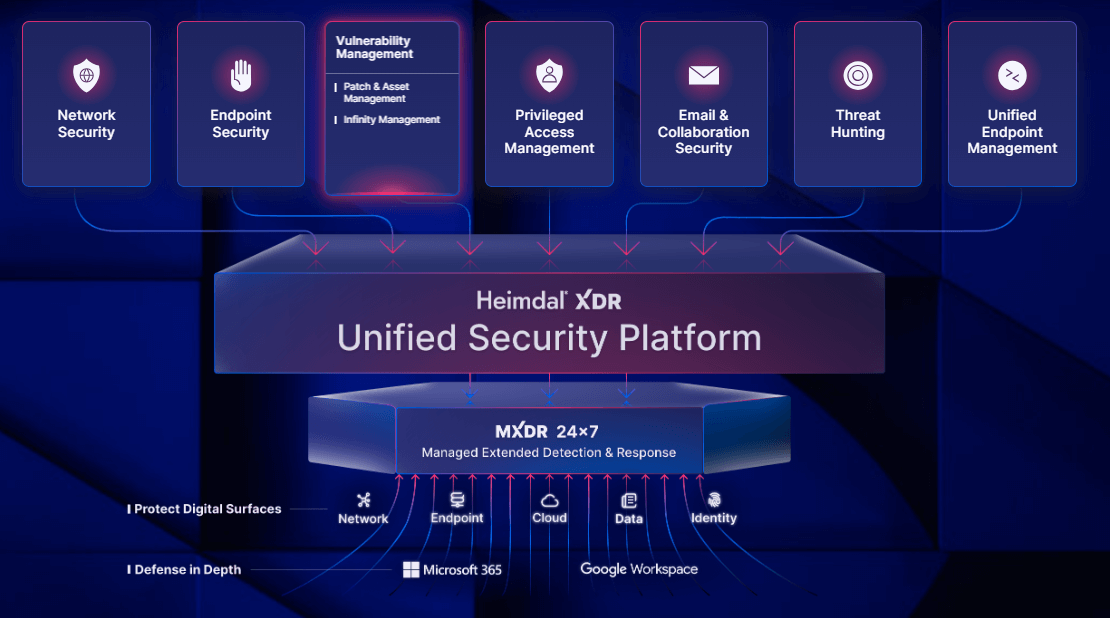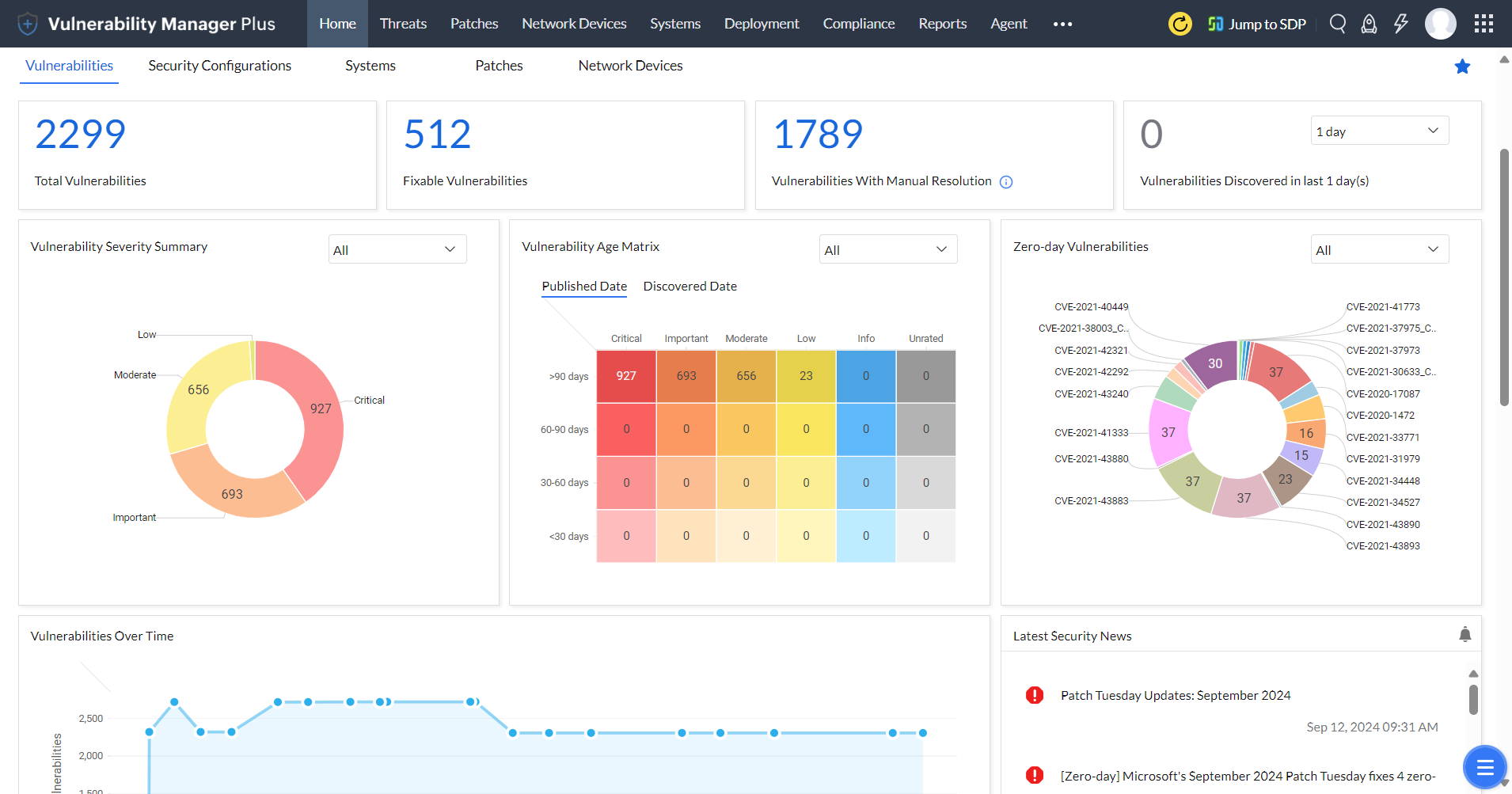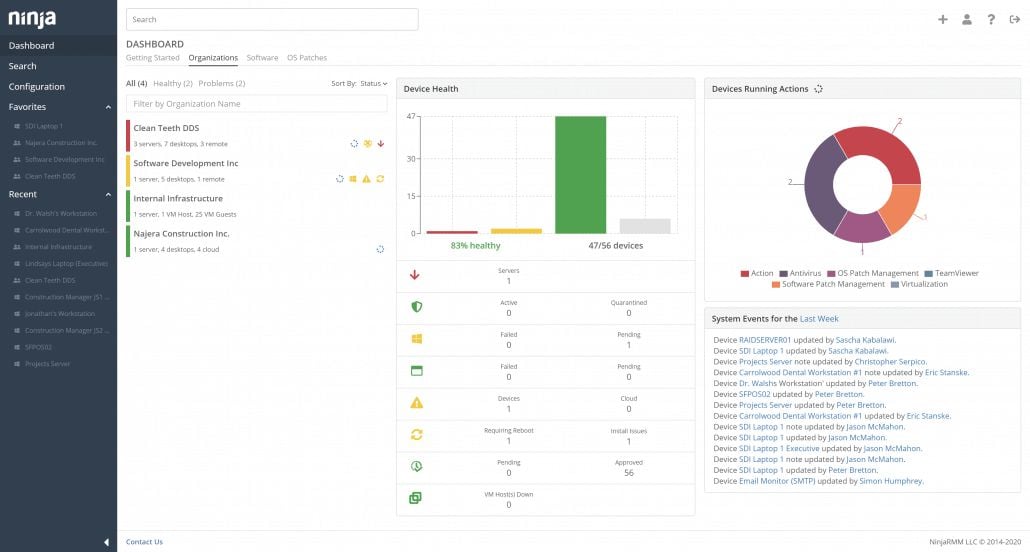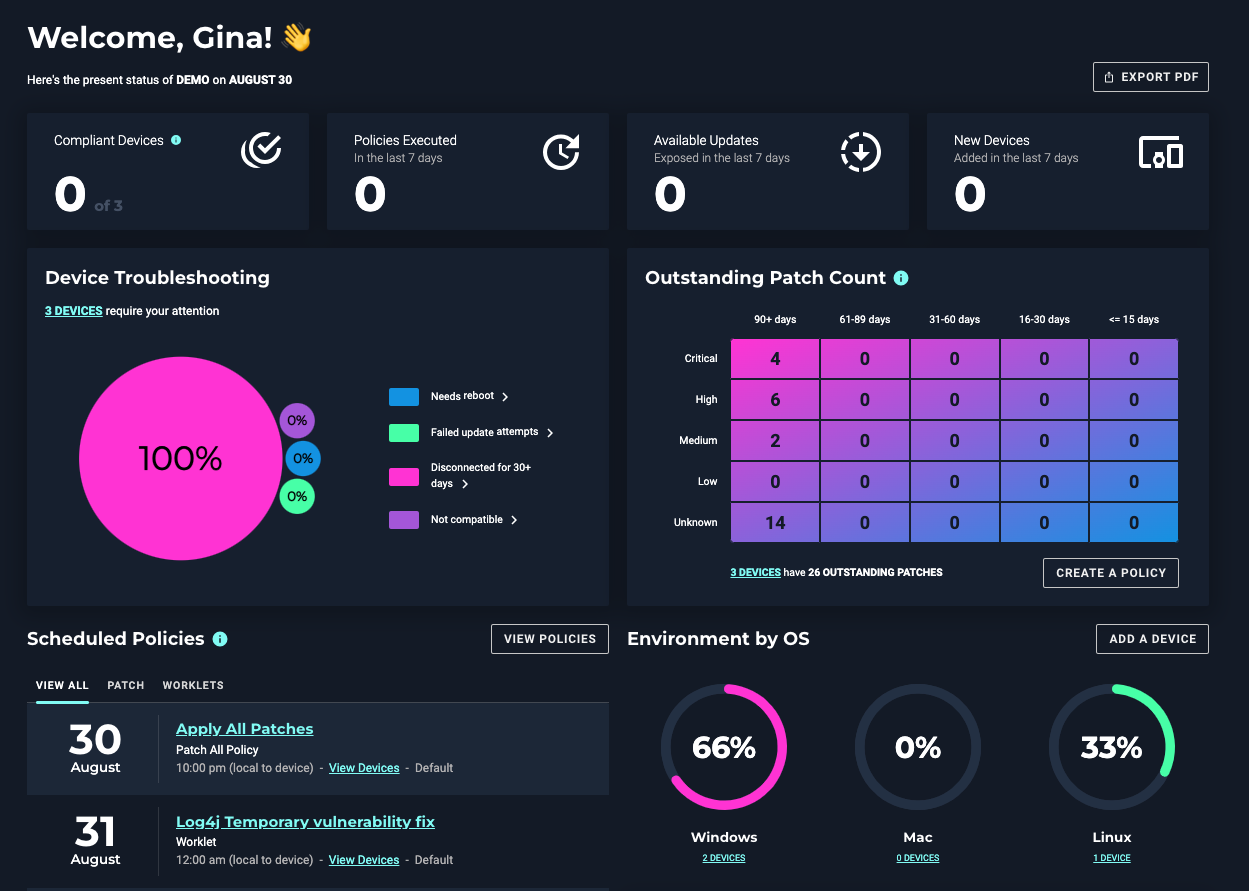Contents:
MSP patch management is one of the most effective yet overlooked cybersecurity practices to keep your operations safe.
With 84% of companies and online businesses reporting suffering at least one cyberattack in the past year, there are plenty of reasons to be concerned.
In this article, we discuss the best MSP patch management software on the market and how to choose the right tools for your IT environment.
Key Points
- The best MSP patch management product on the market
- The buying guide: What to consider when choosing the right software?
- Start patching the right way: Best practices and our cheatsheet
- The risks of choosing the wrong patch management software
- Heimdal: The unified security platform suited for MSPs
- Frequently asked questions (FAQs)
The Best MSP Patch Management Software on the Market
Here are the top five patch management software for MSPs in 2026:
- Heimdal® for Streamlined MSP Patch Management.
- ManageEngine Vulnerability Management Plus for Centralized Control.
- NinjaOne for Simplified IT Operations.
- Automox for Cloud-Native Patch Management.
- Action1 for Cloud-Based Patch Deployment.
1. Heimdal® Patch & Asset Management

Heimdal Patch and Asset Management is the go-to solution for MSPs seeking seamless patch management.
It makes it easy to manage patches for all your clients from one central place, helping you keep on top of newly released patches across multiple tenants and operating systems.
With Heimdal, you can automatically update software on all major operating systems like Windows, macOS, and Linux.
Heimdal also ensures simple compliance with industry regulations like GDPR, Cyber Essentials, CIS18, NIS2, and more.
This empowers you to have full control over scheduling and deployment, including custom or hands-free setups and policies that won’t disrupt end-users, whether they’re onsite, hybrid, or globally distributed.
Pros
- Heimdal offers comprehensive patch management for multiple clients, streamlining MSP operations
- Automation of patch deployment saves time, while reducing manual effort and human error
- Ensures compliance with industry regulations, enhancing security and trust
- Customizable scheduling minimizes disruptions for clients
- Supports a wide range of third-party applications for comprehensive protection
- Swift patch delivery, typically within four hours, keeps systems secure
- Easy enforcement of patching policies across all client systems
- Infinity Management add-on enables further automation for client-specific applications
The Heimdal platform contains many different components. We are only subscribed to the two that currently fit our business needs: Patch & Asset Management, and Remote Desktop. The former is a superb tool for automated patching of operating systems and 3rd party software, plus contains a tool to deploy custom scripts and applications – very versatile.
Cons
- New users may find the learning curve difficult to master
- Requires a stable internet connection for effective operation
The solution is so secure that when I forget the master password I struggle to break into my own system. I had a few struggles with support when I started using the product but all were resolved as I got better acquainted with the solution.
Pricing
Heimdal offers custom pricing based on your needs. Get in touch with us, book a demo, and one of our representatives will take care of you and discuss all the details.
We use Patch Management, E-mail Security and Remote Desktop modules from the Heimdal® portfolio. All these products run through a single agent and consistently perform well. We push Microsoft patches every month to clients and servers without issue (and more reliably than something like WSUS) , Remote Desktop is simple to use as an admin, just right-click the agent search for the user you want to connect to and go, and E-mail Security Spam filtering catches the majority of the bad things. Heimdal® also creates a decent asset register for each device you install the agent on. Support is also responsive and helpful, normally coming back with an answer in only 30 minutes!
Heimdal® User Review from G2 (Source)
2. ManageEngine Vulnerability Management Plus

ManageEngine Vulnerability Management Plus makes patching easy by bringing all the tasks into one place, perfect for organizations with different types of networks. It helps IT pros manage software patches efficiently across different systems while keeping everything secure and compliant.
One great thing about it is its automatic patching, which ensures patches are regularly installed with minimum effort from the security team. It also scans networks thoroughly to find and fix security issues.
Plus, it supports lots of different operating systems and software, so it’s useful in many situations.
Pros
- ManageEngine Vulnerability Management Plus offers comprehensive and centralized control
- Supports a variety of operating systems
- Provides detailed vulnerability assessments
Cons
- Requires a minimum 10-seat purchase
- Has a steeper learning curve
- Offers limited third-party integrations
Pricing
Starting from $34/user/month.
Testimonials
+ ManageEngine Patch Manager Plus is a very simple product to set up and use. We are testing it out with about 20 systems and so far it is working very well. We had just been using WSUS previously and we were finding that a lot of systems were not getting updated, especially if they were not on the network for long periods of time. PMP takes care of that and updates the systems no matter where they are. It also handles many 3rd party apps as well as hardware updates like drivers and system firmware. We plan to roll this out to the entire organization.
ManageEngine Vulnerability Management Plus User Review on G2 (Source)
– Configuring Patch Manager Plus first-time needs expertise on patch management, while it has a wide supported range of third-party apps but uninstallation option is available only for few apps.
3. NinjaOne (Formerly NinjaRMM)

NinjaOne has a number of integrated software tools like automatic patching, custom scripting, and real-time remote monitoring. Its dashboards are easy to understand and help with compliance reporting – essential for reducing potential legal consequences of a breach.
Plus, the product works well with other popular IT tools and cloud storage services like Dropbox and Google Drive, so it fits right into your existing setup.
Pros
- NinjaOne’s automation capability transforms internal IT departments into highly efficient operations
- The platform provides comprehensive insights into assets and network security, enabling proactive management
- Integrated ticketing and documentation modules streamline IT processes, serving as a one-stop hub
Cons
- Occasional service disruptions to regional instances may occur, but with no significant outages reported
- The platform’s learning curve for new users might require time to adapt
- The product depends on a stable internet connection, which may affect effective operation
Pricing
Starting from $3/user/month.
Testimonials
+ I like the fact that the software is easy to use. It is also easy to add devices to the app. I like that they are adding features. I use this everyday all day. I like the fact that you can integrate other apps to NinjaOne so that you have a single pane of glass to access everything you need.
NinjaOne Review on G2 (Source)
– Their ticket system could be more robust but it has handled everything we needed.
4. Automox

Automox handles patch management in the cloud, covering everything from finding to installing updates, which is great for keeping remote devices safe. It’s flexible and can grow with your organization, especially if you work a lot in the cloud.
Automox is known for automatically finding your systems, regularly checking for vulnerabilities, and offering automated policies according to your own custom rules.
Plus, it works well with other popular tools like Slack, Jira, and Webhooks, which helps keep everyone in the loop.
Pros
- Tailored for contemporary, dispersed organizations, being a cloud-native platform
- Includes automated patch management tools to simplify manual security oversight
- Seamless integration with commonly used third-party patch management tools enhances communication and collaboration
Cons
- May not be the optimal choice for organizations with on-premises assets.
- Annual pricing models may not align with the preferences of certain businesses
- Setup and configuration demand a high degree of technical proficiency
Pricing
Starting from $3/user/month.
Testimonials
+ Automox is really great with the patching process. We’ve created several policies for different items. We have a policy that automatically updates web browsers and selects 3rd party software.
Automox Review on G2 (Source)
– The least helpful would be the worklet catalog, only because I wish it would update with new worklets more often. I also wish there was a way for Automox to run Bios updates if needed.
5. Action1

Action1 is a cloud-based solution designed to automate patch deployment for remote teams. The cloud-based tool makes it easier to handle patches for remote workers.
Action1 stands out because it automatically checks for patches, gives real-time reports, and works on different systems, so it’s flexible for businesses with various operating systems.
Plus, it works well with popular systems like Active Directory and SCCM, so it fits right into your existing setup.
Pros
- Optimized for remote workforce management, with its cloud-based architecture
- Real-time reporting offers instant visibility into patch compliance status
- Comprehensive multi-platform support caters to various operating systems
Cons
- Minimum seat requirements may not align with the needs of smaller organizations
- Potential learning curve for IT teams unfamiliar with patch management processes
- Limited feature set compared to certain enterprise-level solutions
Pricing
Starting from $10/user/month
Testimonials
+ The Action1 team is responsive to customer inquiries and developing sought-after features. The remote viewer capability works well and meets my basic needs. I’m still working away at the patch management but it appears to be sufficient.
Action1 Review on G2 (Source)
– The current platform unfortunately only supports Windows. I know there are roadmap plans to include support for other operating systems, but as of May 2024, those are still “roadmap” items. No notification on “when”.
The Buying Guide: What to Consider When Choosing the Perfect MSP Patch Management Software?
When it comes to selecting the ideal patch management solution, there are several crucial factors to consider.
Here’s a concise breakdown to help you make the right choice:
1. Automation
Opt for a solution that automates patching processes to save time and reduce manual errors.
Automation ensures timely updates without the need for constant supervision.
2. Remote Accessibility
Look for a platform that offers 24/7 access from anywhere, enabling you to manage patches remotely and respond promptly to emerging threats, even when you’re on the go.
3. Custom Policy Implementation
Choose a solution that allows you to implement a robust patch management policy tailored to your organization’s specific needs and compliance requirements. Flexibility in policy creation makes it much easier to address security vulnerabilities by prioritizing the most critical patches for your specific organization.
4. Device Control
Ensure the solution provides granular control over which devices to patch, allowing you to prioritize critical systems and avoid disruptions to essential operations.
5. Maintain Compatibility Across Platforms
Check that the solution supports patching for a diverse range of operating systems, including Windows, Linux, and macOS. This ensures protection across your entire IT infrastructure.
6. Scalability
Consider the scalability possibilities of the solution to accommodate future growth and evolving business needs.
A scalable patch management solution can adapt seamlessly to changes in your organization’s size and complexity.
7. Security Features
Assess the security features offered by the solution, such as vulnerability assessments, threat intelligence integration, and patch validation mechanisms.
Robust security measures enhance protection against cyber threats and security breaches.
8. Reporting and Analytics
Evaluate the reporting and analytics capabilities of the solution, which provide insights into patching activities, compliance status, and potential vulnerabilities.
Comprehensive reporting enables informed decision-making and proactive risk management.
By prioritizing these aspects, you can be confident that the remaining patch management solutions offer the best mix of efficiency, flexibility, and security.
Making the right choice today will keep you safe from tomorrow’s threats.
Start Patching The Right Way: Best Practices + Our Cheatsheet
Patching means updating software to fix problems and make it more secure.
It’s super important for keeping your organization safe from hackers who love to exploit vulnerabilities in outdated systems.
Here’s how to do it right:
- Make a patching plan: Write down how you’ll find, test, and deploy patches. This keeps things clear and consistent.
- Check for vulnerabilities: Scan your systems regularly to find weak spots. Then, fix the most urgent ones first.
- Focus on critical issues: Not all patches are urgent, but some are. Start with the ones that protect against serious threats.
- Test patches first: Before updating all your systems, try out patches in a safe place to avoid any surprises.
- Stick to a schedule: Set regular times to update, so you’re always on top of it without causing chaos.
- Use automation: Tools that create automated processes for patching that save time and effort, making life easier.
- Keep an eye on compliance: Make sure all your systems are up to date and following the rules.
- Educate your team: Teach your staff why patching matters and how to do it right.
To kickstart your patching journey, grab our free patch management template/cheatsheet.
It’s packed with practical advice to help you patch like a pro and keep your organization secure. Download it now and get patching.
Start Patching the Right Way: Best Practices + Our Cheatsheet
Patching means updating software to fix problems and make it more secure.
It’s super important for keeping your organization safe from hackers who love to exploit vulnerabilities in outdated systems.
Here’s how to do it right:
- Make a Patching Plan. Write down how you’ll find, test, and install patches. This keeps things clear and consistent.
- Check for Vulnerabilities. Scan your systems regularly to find weak spots. Then, fix the most urgent ones first.
- Focus on Critical Fixes. Not all patches are urgent, but some are. Start with the ones that protect against serious threats.
- Test Patches First. Before updating all your systems, try out patches in a safe place to avoid any surprises.
- Stick to a Schedule. Set regular times to update, so you’re always on top of it without causing chaos.
- Use Automation. Tools that automate patching save time and effort, making life easier.
- Keep an Eye on Compliance. Make sure all your systems are up to date and following the rules.
- Educate Your Team. Teach your staff why patching matters and how to do it right.
To kickstart your patching journey, grab our free patch management template/cheatsheet.
It’s packed with practical advice to help you patch like a pro and keep your organization secure. Download it now and get patching.
Heimdal: The Unified Security Platform Suited for MSPs
Heimdal is trusted by Managed Service Providers worldwide for its complete cybersecurity toolkit.
Explore our award-winning solutions suited for MSPs.
Heimdal has the world’s widest cybersecurity platform, featuring products for:
- Network security
- Vulnerability management
- Privileged access management
- Endpoint management
- Threat hunting
- Email and collaboration security
If you’re offering cybersecurity as one of your managed services, Heimdal empowers you with everything you need to succeed!
Join Our Partner Program: Partner NEXUS
Heimdal also offers a partner program tailored to MSPs, MSSPs, distributors, and resellers: Partner NEXUS. The program aims to improve customer security and expand business opportunities.

So, why should you join? As an MSP, MSSP, distributor, or reseller, you gain access to a comprehensive cybersecurity kit, a user-friendly platform that simplifies security management, and extensive training and support for you to focus on growth and turn the tide against cyberattacks.
Moreover, you get the best in cybersecurity:
- The most extensive XDR suite on the market
- Unified management for simplified control
- Next-level threat intelligence
- Reliable and efficient cloud-native architecture
- Innovative telemetry and responsive capabilities
- Managed SOC services with exceptional support
Get Ahead With Our 2026 MSP Patch Management Guide
Our MSP patch management guide is packed with tips and tools to boost your system’s security.
Whether you’re a pro or just starting out, our guide covers top software choices and important factors for picking the best solution.
Plus, our template makes patch management a breeze, helping you protect your clients’ systems like a pro.
Frequently Asked Questions (FAQs)
What is MSP Patch Management?
MSP patch management refers to the process by which Managed Service Providers (MSPs) oversee and administer software updates, commonly known as patches, across the IT infrastructure of their clients.
This includes identifying available patches for various software applications and operating systems, testing them for compatibility issues and reliability, deploying approved patches to client systems, and ensuring that all devices are up to date with the latest security and performance updates.
What Does Patch Management Software Do?
Patch management software automates the process of identifying missing patches, testing, and deploying software updates, ensuring systems are up to date with the latest security patches and minimizing the manual intervention required from your team.
It prioritizes patches based on severity, tests them for compatibility, and monitors systems for new updates, helping organizations maintain compliance and enhance cybersecurity. This is one of the key benefits of an effective patching product.
How to Implement Patch Management Software?
Analyze your current patch management process, update or create your patch management policy and invest in effective asset inventory management. Then, choose the best patch management tool and find out the rest from this guide: How to Implement Patch Management Software.
Why Do We Need Patch Management?
Patch management is essential for maintaining the security and stability of your entire network by promptly applying software updates and security patches to address software vulnerabilities and protect against cyber threats.










 Network Security
Network Security
 Vulnerability Management
Vulnerability Management
 Privileged Access Management
Privileged Access Management  Endpoint Security
Endpoint Security
 Threat Hunting
Threat Hunting
 Unified Endpoint Management
Unified Endpoint Management
 Email & Collaboration Security
Email & Collaboration Security














